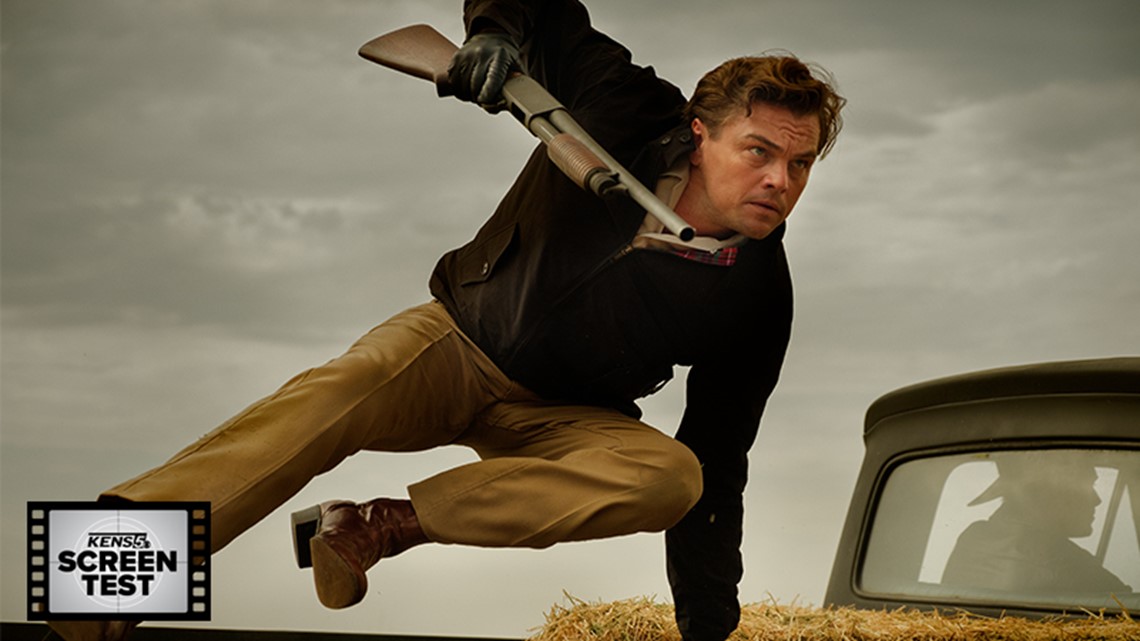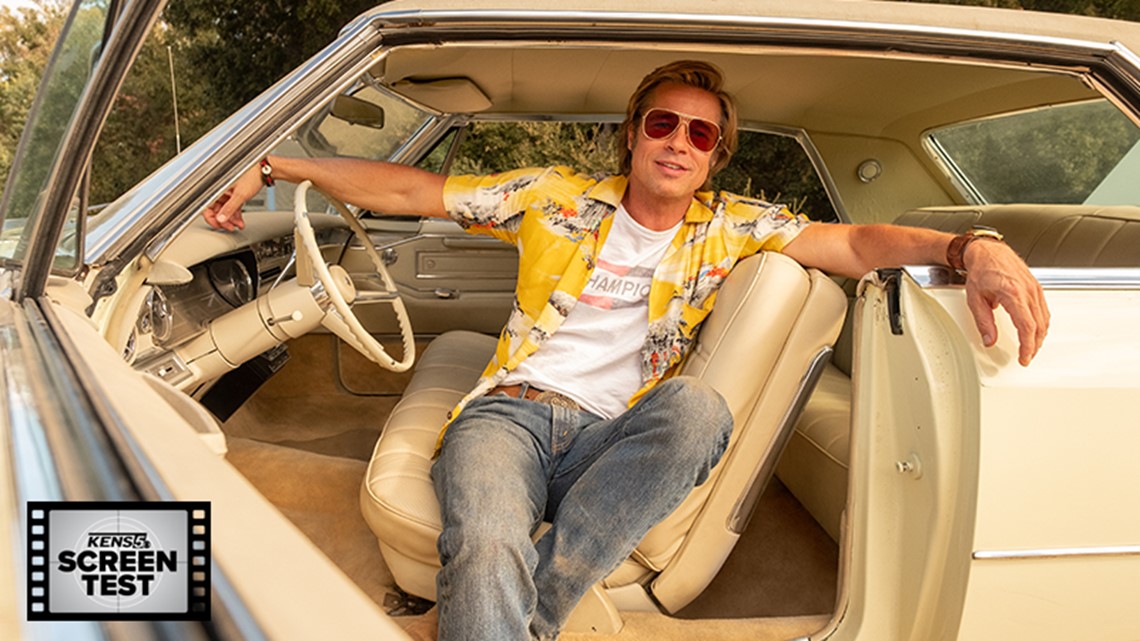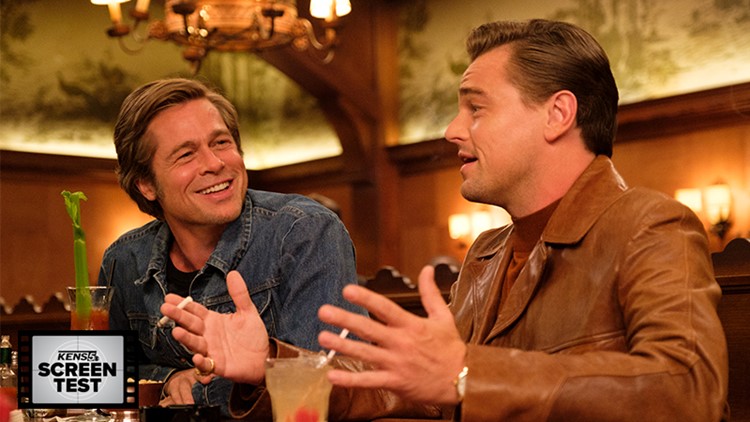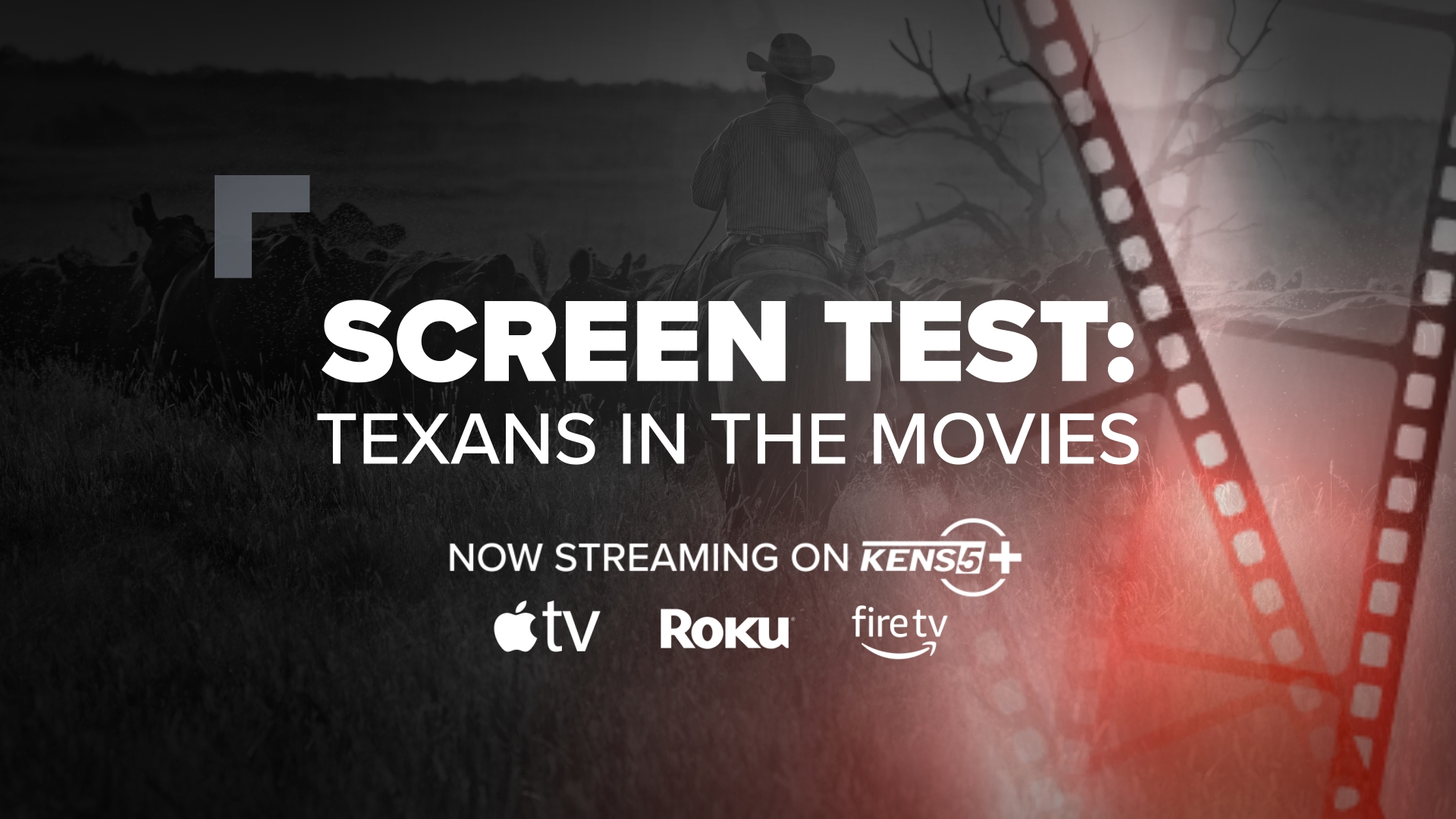There’s a shot early in “Once Upon a Time…in Hollywood” that will strike those fluent in the cinematic language of its writer-director, Quentin Tarantino, as something very anti-Quentin Tarantino.
The camera is closed in tight – real tight, as if ready to surprise – on a swatch of paint, and begins to move, gingerly, over what we eventually come to recognize as the illustrated face of Rick Dalton, Leonardo DiCaprio’s fictionalized drunken actor in 1969 Los Angeles. The face eventually comes to take up the entire frame, feeling larger than life, but we’re still not quite sure where we are—there’s no background chatter, no camera flashes. Just morning ambience.
It’s an uncharacteristically quiet moment to open a Tarantino film, like the auteur paying a more patient kind of homage to the cinema he’s built a career of borrowing from and remixing. As if he, and we, are observing it from a church pew.
Not too long after, the impression is shattered. Tarantino reveals the grand nature of that opening to be a fakeout—instead of a massive billboard overseeing Sunset Boulevard, the artwork is propped up on cinder blocks on the end of a driveway, like an artifact time has forgotten. It’s a plot-building surprise right up the alley of a director whose name itself evokes polarization and debate. “Once Upon a Time…” – an evocative, romantic, violent, metatextual, questionable reimagining of a time and place that is all of those things – will also be polarizing, and absolutely lead to debate.
Tarantino’s ninth film is a legitimate work of art – don’t conflate that with masterpiece – and an endangered species that works beyond the simple binary of good or bad, of rotten or fresh, a specimen that begs to be dissected. Surely it will be for years. This is the director at his most confident, and it’s the director at his most restrained. The level to which “Once Upon a Time…” stands out in 2019 – alongside the Lion Kings, Endgames and fifth Men in Black installments of the world – is striking, and may end up saying more about the current epoch of the industry than what this movie actually does. But what is art if not considering its context?
The story is told through a triptych of stages of stardom in a vaguely-familiar Hollywood, embodied by some of our most well-known working actors in peak form: DiCaprio’s Rick, made vulnerable by success; Brad Pitt’s Cliff Booth, made unbendable by a lack of it; and Margot Robbie’s Sharon Tate, in the very early stages of acquiring it. In Rick and Cliff, Tarantino has crafted another signature relationship, but one rooted in empathy to a level we hadn’t yet seen from the director and, depending who you ask, a level we didn’t think he was interested in. Sharon is realized with just as much sentimentality, but in a much different way; unlike Rick and Cliff, she was real, and has a real story widely recognized for its tragedy more than anything else.
While the things motivating these characters in “Once Upon a Time…” are very different from what motivates the Basterds of “Inglourious Basterds” or Beatrix Kiddo in “Kill Bill” – revenge is a quintessential Tarantintrope that’s absent here – the director familiarizes us with them in ways that prove he’s come far as a filmmaker and, perhaps more importantly, prove he’s capable of recognizing it.
In his case, growth means the discovery of subtlety; in a trio of parallel sequences not far into the movie’s first act, we are with Rick, Cliff and Sharon as they drive through an exquisitely-realized, neon-lit Los Angeles, a version of the Hollywood Tarantino himself grew up in. The differences in these journeys – from how they’re shot to their companions to the distinct songs that accompany them – serve as a memorably brilliant way to color in their inner psyches, something Tarantino typically relies on fiery dialogue to accomplish. The conversations in the movie do employ some of his signature quirks, but for a director whose most memorable scenes are crafted around epic monologues and language as chess matches, Tarantino tapers back the complexity of dialogue in “Once Upon a Time…” in favor of other creative liberties, including a camera – operated by evergreen collaborator Robert Richardson – that’s more explorative than anything he’s done before. Tarantino’s movies are typically attracted to the sinister, and in a movie that goes long stretches without a sniff of sinister, the camera is more of a graceful companion, the first signal that this is a hangout movie before anything, even as it’s anticipating a burst of profanity or bloodshed we’ve come to expect from the director.


Tarantino has always seemed to get a bit of joy from veering dangerously close to being stylish for style’s sake. In trading his trademark explicit, kinetic energy for something clearly wanting to be more meaningful, “Once Upon a Time…” is able to create a sensation new for Tarantino: a pervading melancholy that coats most of this affair, along with classic marquees, Summer of Love hippies, Hollywood moviemaking magic and, if you’re aware of the darkness 1969 brought to Cielo Drive in the form of the Manson Family, a historically-incepted sense of foreboding.
Yet the more relaxed ride has the effect Tarantino is undoubtedly striving for—making it feel like we’ve stepped beyond the screen, and directly into his fantasia.
Violence will eventually find its way to the story – this is still Tarantino, after all – and its arrival is tonally at odds with the rest of the movie. But on the way there, most of “Once Upon a Time…”’s 160 minutes are patient, pensive, peaceful; the intersection of Tarantino’s love for cinema and allure to pop culture’s magnetism creating yet another sandbox for him to blur his reality with the history we know, for better and for worse. It has more in common with “Hail, Ceasar!” than “La La Land,” yet its juxtaposition to the latter arguably provides greater fodder for comparison.
The movie’s sentiments about stardom are legion – and the sum of its parts, I think, greater than the whole – yet I couldn’t help but feel enraptured by Tarantino’s strange and surprising exploration of it, via a movie that largely unfolds across the tapestry of a couple days. For 27 years the auteur has been subverting the forms of cinema we were accustomed to, and now he’s subverting himself. The movie is more epiphany than self-imitation, but never before has the way we view Tarantino’s films influenced how we’ll respond to his ninth one.
What are movies for, what are they meant to do? Once upon a time, amid the current age of IP maximization and franchise Frankensteining, we began to think we were safe from having to think about that. By making a movie about movies, Tarantino has thrust it back in the cultural consciousness – an adrenaline shot puncturing our box office-obsessed hearts – and his own ruminations begin with Rick and Cliff. Tarantino keeps audience expectations at the fore with the central pair, directing DiCaprio and Pitt to a pair of the year’s more mesmerizing and fully-realized performances, even as they represent a study in contrasts in relation to their stardom, or lack thereof.
Robbie, meanwhile, is elegiac and elegant as Sharon, oftentimes the allure of Tarantino’s oft-exploitative male gaze, but to an even larger extent the heart and soul of this fictionalized Hollywood. Robbie, sans many lines, brings a humility that hasn’t been glimpsed in a Tarantino since “Jackie Brown” 20 years ago; the manner in how Sharon is welcomed to a theater where her movie is showing is among the most considered things Tarantino has ever done. In a movie where the director goes to his characteristically meticulous lengths to recreate classic scenes with DiCaprio’s presence, there’s a lot to be said for him not altering scenes of Dean Martin’s “The Wrecking Crew” with the real Sharon Tate at the center. Watching Robbie respond simultaneously to herself and a classic Hollywood starlet is the kind of stuff only Tarantino can come up with, and his toying around with reality and fiction has rarely felt like such a specifically Los Angeles idea as in the movie.
It’s the same reason why images of Robbie dancing, watching movies and serenely strolling through the city that was once preparing itself to follow in her every step feel destined to be “Once Upon a Time…’s” iconic scenes, especially when viewed through the lens of the movie’s wistful final moments.
The film’s extended middle section – switching between Rick, Cliff and Sharon in individual situations unfolding simultaneously – is the movie’s best, a character-driven stretch of sequences playing out seemingly in real time, and with real efficiency of conceptual deconstruction. Rick’s journey-in-miniature, on set at a Western TV pilot, may be the best short movie of the year; I perceived a memorable interchange between the unsure actor and the 8-year-old girl he’ll soon share a scene with (a too-good-for-words Julia Butters) as one rich with theme and commentary on where the movie industry has been and gone.
But what was, for me, the most transparently poignant moment of self-reflection on Rick’s part was also perceived by many in my screening, understandably, to be a laugh line. Perhaps Tarantino’s intention was to create the possibility the scene can be both. Yet if that’s the case, it’s an oft-seen example of the purely unapologetic filmmaker sympathizing with how we may absorb a scene. How do we reconcile a late-blooming sense of empathy with a director so universally regarded for soaking plot, character and mood in abrasiveness, often to the point of feeling cartoonish? Is it our job to try to?


These questions extend most emphatically to the film’s final 25 or so minutes – an ending that sees Tarantino reverting (relegating?) himself to his traditionally outlandish brand of unrestrained violence – as well as a few select scenes scattered throughout that, upon initial viewings, feel like little more than inextricable cinematic ticks that Tarantino simply must return to. They’re memorable, but unlike the film’s most rewarding moments, they’re memorable for how they counteract the otherwise blissful agenda of “Once Upon a Time….,” explicit suggestions of a fascination with violence that Tarantino suddenly shoves upon us, while most of the movie steps back far enough to glean its observations for ourselves.
Dissection, in these moments, is abandoned for toleration, but how any individual viewer chooses to perceive them is still anchored to how familiar they are with Tarantino—the films, the discourse, the controversies. Even in the rare pang of brashness in “Once Upon a Time…,” we find ourselves framing it within the context of the man behind it.
So perhaps that begs the question: Tarantino already feels like a remnant of another time – an era pre-#MeToo, an age before widespread Hollywood ubiquity – or at least a remnant who has yet to adapt to the modern industry’s rules, and who indeed refuses to. Is his the last name of a director for whom simple anticipation of a new movie leads to discourse? Is that even a good thing? “Once Upon a Time…’s” existence alone comes across as an indictment of the director’s critics, yet it’s still a homily to an industry, a place, an age he has to know will always be bigger than he is, despite his throwing a cathartic, sweet wrench into our perception of it by movie’s end. It owes no allegiance to the audience, and because of exactly that, it provides so much.
Cinema more than ever feels contained to the cinema. “Once Upon a Time…in Hollywood” instead sneaks home with you even after you’ve gotten your fill. It leaves you engaged in its decisions, brooding about its paradoxes, immersed in its fermented flavor. With his latest film, Tarantino engages much more than just our senses. He’s turned the cinema back into a place of worship once again.
“Once Upon a Time…In Hollywood” is rated R for language throughout, some strong graphic violence, drug use, and sexual references
Starring: Leonardo DiCaprio, Brad Pitt, Margot Robbie, Emile Hirsch
Directed by Quentin Tarantino
2019



